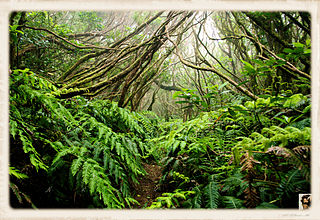
Laurel forest, also called laurisilva or laurissilva, is a type of subtropical forest found in areas with high humidity and relatively stable, mild temperatures. The forest is characterized by broadleaf tree species with evergreen, glossy and elongated leaves, known as "laurophyll" or "lauroid". Plants from the laurel family (Lauraceae) may or may not be present, depending on the location.
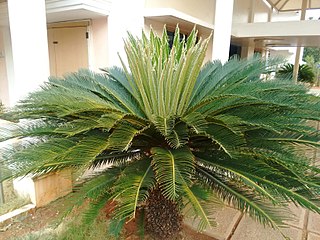
Cycas is a genus of plants belonging to a very ancient lineage, the Cycadophyta, which are not closely related to palms, ferns, trees or any other modern group of plants. They are evergreen perennials which achieved their maximum diversity in the Jurassic and Cretaceous periods, when they were distributed almost worldwide. At the end of the Cretaceous, when the non-avian dinosaurs became extinct, so did most of the cycas in the Northern Hemisphere.

Tainia, commonly known as ribbon orchids or 带唇兰属 is a genus of about thirty species of evergreen, terrestrial orchids in the distributed from India, China, Japan, Southeast Asia to New Guinea, the Solomon Islands and Queensland.

The environment of Sri Lanka is unique in being one of the world's bio-diversity hot-spots.
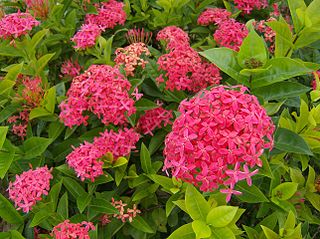
Ixora is a genus of flowering plants in the family Rubiaceae. It is the only genus in the tribe Ixoreae. It consists of tropical evergreen trees and shrubs and holds around 562 species. Though native to the tropical and subtropical areas throughout the world, its centre of diversity is in Tropical Asia. Ixora also grows commonly in subtropical climates in the United States, such as Florida where it is commonly known as West Indian jasmine. Other common names include viruchi, rangan, kheme, ponna, chann tanea, techi, pan, siantan, jarum-jarum/jejarum, jungle flame, jungle geranium, and cruz de Malta, among others. The plants possess leathery leaves, ranging from 3 to 6 inches in length, and produce large clusters of tiny flowers in the summer. Members of Ixora prefer acidic soil, and are suitable choices for bonsai. It is also a popular choice for hedges in parts of South East Asia. In tropical climates they flower year round and are commonly used in Hindu worship, as well as in ayurveda and Indian folk medicine.

Ixora coccinea is a species of flowering plant in the family Rubiaceae. It is a common flowering shrub native to Southern India, Bangladesh, and Sri Lanka. It has become one of the most popular flowering shrubs in South Florida gardens and landscapes. It is the national flower of Suriname.

Ixora margaretae is a species of plant in the family Rubiaceae. It is endemic to New Caledonia. It is threatened by habitat loss.
Ixora johnsonii is a species of flowering plant in the family Rubiaceae. It is endemic to Ernakulam in the state of Kerala, India.
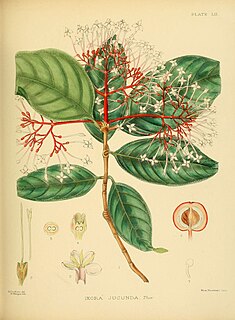
Ixora jucunda is a species of flowering plant in the family Rubiaceae. It is endemic to Sri Lanka.
Ixora lawsonii is a species of flowering plant in the family Rubiaceae. It is native to Karnataka and Kerala in India.
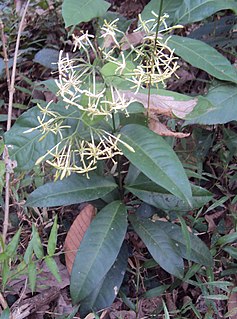
Ixora malabarica is a species of flowering plant in the family Rubiaceae. It is native to Karnataka and Kerala in India.
Ixora saulierei is a species of flowering plant in the family Rubiaceae. It is endemic to Tamil Nadu in India.

Rhododendron arboreum, the tree rhododendron, also known as Burans or Laligurans or simply Gurans in Nepal, is an evergreen shrub or small tree with a showy display of bright red flowers. It is found in Bhutan, China, India, Myanmar, Nepal, Sri Lanka, Pakistan and Thailand. Rhododendron arboreum is the national flower of Nepal; in India it is the state tree of Uttarakhand and state flower of Nagaland.

Virola elongata is a species of tree in the family Myristicaceae. The tree is native to Panama, Guyana, Brazil, Bolivia, Colombia, Ecuador and Peru. It is also found in Suriname. Virola elongata is thin and 7.5–23 m (25–75 ft) tall, sometimes 30 m (98 ft) tall.

William Philip Hiern was a British mathematician and botanist.

Ixora nigricans, or black ixora, is a plant growing up to a height of 5 metres. It is found as common undergrowth in evergreen forests to dry evergreen forests up to 1900 m. Black ixora is found in throughout the forests of the Western Ghats of India.

Mecopoda elongata is a species of bush cricket of the subfamily Mecopodinae. Species can be found in India, Sri Lanka, Indo-China, China, Taiwan, Malesia through to Melanesia.

Ixora chinensis, commonly known as Chinese ixora, is a species of plant of the genus Ixora.

Acacia elongata, also known as swamp wattle or slender wattle, is a shrub of the genus Acacia and the subgenus Plurinerves that is endemic to coastal areas of eastern Australia.
















